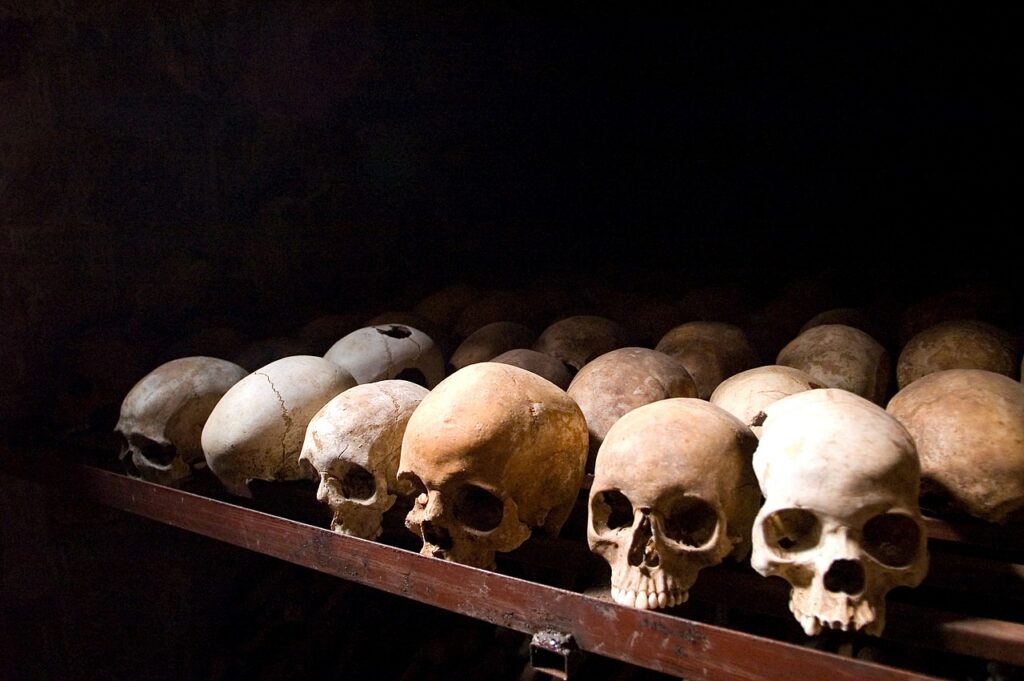According to the 1948 Convention, genocide means any of the following acts committed with intent to destroy, in whole or in part, a national, ethnical, racial or religious group, as such:
- Killing members of the group;
- Causing serious bodily or mental harm to members of the group;
- Deliberately inflicting on the group conditions of life calculated to bring about its physical destruction in whole or in part;
- Imposing measures intended to prevent births within the group;
- Forcibly transferring children of the group to another group.
The term genocide is of recent derivation; etymologically, it combines the Greek for group, tribe-genos, with the Latin for killing-cide.

In 1933, the jurist Raphael Lemkin submitted to the International Conference for Unification of Criminal Law a proposal to declare the destruction of racial, religious or social collectivities a crime in international law. In 1944 he published a monograph, Axis Rule in Occupied Europe, in which he detailed the exterminatory and other practices and policies pursued by the Third Reich and its allies. He went on to argue the case for the international regulation of the “practice of extermination of nations and ethnic groups,” a practice which he referred to now as genocide.
Lemkin was also instrumental in lobbying United Nations officials and representatives to secure the passage of a resolution by the General Assembly affirming that “genocide is a crime under international law which the civilized world condemns, and for the commission of which principals and accomplices are punishable.” The matter was referred for consideration to the UN Economic and Social Council, their deliberations culminating with the signing of the 1948 United Nations Convention on Genocide (UNCG).
Although every mass killing involves unique circumstances, certain underlying conditions are common to most genocide acts. The offending nation, or perpetrator, is usually a non-democratic country that views the targeted group as a barrier or threat to maintaining power, fulfilling an ideology, or achieving some other goal.
Most genocide occurs during a crisis such as war, state breakdown, or revolution, and the crisis is blamed by the perpetrators on the victims. In addition, the governments of other countries that might have interfered with or kept silent about the genocide, may support the perpetrators directly or indirectly by their lack of action.
History
Generally-speaking, the history of genocides is linked to the history of colonialism. Christopher Columbus opened the way to the settlers who gradually killed all the native populations of the Caribbean islands and Central America. It happened again with the genocide of the Tasmanian and Aborigines in Australia and the North-American Indians less than 150 years ago. Whole people and cultures have been erased from the planet and will never come back.
The Zunghar Genocide took place in the 18th Century when the ruling Manchu Qing dynasty of China, supported by the Uyghur Muslims of Xinjiang, ordered the mass killing of the Zunghars, a Tibetan Muslim Oirat who were considered to be the members of the last nomadic kingdom of Zunghars Khanate. The massacre was initiated in 1755, after a section of the of the Zunghars rebelled against the rule of the Qing dynasty. The Manchu Generals then suppressed the rebellion by killing off nearly 80% of the Zunghars population in the region, accounting for nearly 500,000 to 800,000 people.
The Armenian genocide occurred between 1915 and 1922 in what was then known as the Ottoman Empire. During this time, as many as 1.5 million ethnic Armenians were brutally murdered by the actions of the Ottoman government, who were acting upon a strong anti-Armenian sentiment.
The number of people killed in the brutal manmade starvation in Ukraine, known as the Holodomor, is estimated at anywhere between 1.8 million individuals to 7.5 million. The majority of those who lost their loves were ethnic Ukrainians, a fact that has led to accusations that the government of the Soviet Union, which was at the time led by Joseph Stalin, intentionally orchestrated the genocide in order to reduce the risk of an uprising from Ukraine.
The Kazakh Genocide saw between 1.3 million to 1.75 ethnic Kazakhs losing their lives to famine and food shortage. Due to the involvement of the Soviet government, scholars have referred to this planned starvation as a genocide.
The Holocaust, ordered by Aldolf Hilter, started in 1941 going to May 1945. Somewhere between 600 000 and 3 million Jews were killed. Genocide also targeted at Slavs, Gypsies and Jehovahs Witnesses as well as other groups, such as homosexuals, prostitutes and communists, as part of a wider democide.
The Circassian Genocide occurred between 1941 and 1945. During this time, anywhere between 357,000 to 600,000 Circassians, people native to the Circassia region of the North Caucasus, lost their lives in the Russo-Circassian War. The genocide was an example of ethnic cleansing.
The Croatian Ustasha Genocide, also known as the Holocaust in Croatia, was an episode of massacre of the Jews inhabiting the region between 1941 to 1945 during the Second World War. It was committed by the fascist Ustaše regime of the Independent State of Croatia, comprising what is today modern day Croatia, Herzegovina, Bosnia and parts of Serbia. The Jews were killed in both Ustaše run concentration camps or handed over to Nazi-run concentration camps for execution.
Japanese are held responsible for several genocides before and during 1920s-1945: the Nanjing Massacre (300,000 people killed in two weeks), the Wan Bao Hill Incident, the Black Sun 731 Project in Manchuria and other targeted at Chinese, Koreans, Philippines, Vietnamese, Indonesians and Burmeses.
After the British left India in 1947, the county was divided on the basis of religion into Pakistan and India. Pakistan included both Western Pakistan, bordering Jammu and Kashmir to the north of India and Eastern Pakistan which is now the independent country of Bangladesh. In 1971, the people of Eastern Pakistan revolted against their government demanding a separate, independent state for themselves. In the nine month Bangladeshi War of Independence fought by the Bengalis of the region, nearly 300,000 to 3,000,000 people were brutally killed by the military force of Western Pakistan. The genocide was launched on March 26, 1971, deemed as Operation Searchlight. A large number of women were also raped during this event. Clashes also broke out between Urdu-speaking Bihari Muslims and Bengali speaking Muslims in the region. The war ended with the formation of the newly independent nation of Bangladesh.
In the Cambodian Genocide between 1975 and 1979, between 1.5 and 3 million people were killed by the brutal policies of the Khmer Rouge regime. People were forced to relocate, forced into labor, subjected to inhumane torture and other forms of atrocities. Many people were by killed by mass executions while others died from disease, starvation and malnutrition. This killing spree by the Khmer Rouge led by Pol Pot was undertaken with an objective of establishing a form of agrarian socialism in Cambodia. The invasion of the country by Vietnamese forces finally ended the genocide and brought respite to the people of the country.
The Rwandan genocide witnessed the death of nearly 500,000 to 1,000,000 Rwandans, accounting for nearly 20% of the country’s population and 70% of the country’s Tutsi populace. The genocide took place over a period of 100 days from April 7th through mid-July of 1994. The massacre was initiated by the Rwandan Government comprising of a Hutu-led government against the Tutsis during the Rwandan Civil War in response to the rebellion by the Tutsi led Rwandan Patriotic Front. Moderate Hutu leaders were also executed during the Rwandan genocide. In the aftermath of the genocide, the economy of Rwanda was in despair, many households of the Tutsis were headed by only women or orphaned children and the ravages of genocidal rape led to a spike in Human Immunodeficiency Virus (HIV) cases in the country. Today, Rwanda mourns the death of the genocide victims on two public holidays, April 7th and July 4th.
The “ethnic cleansing” in the remnants of Yugoslavia led by Milosevic and other fascists groups (Serbs, Croats, and Bosniaks). More than 7,000 Muslim men and boys were massacred in Srebrenica in July 1995.
Today
Where : Tibet
Oppressor: China
Who : the Tibetans
Within some six centuries of the introduction of Buddhism, Tibet was prosperous and entirely at peace. Then in 1959 the Chinese came. During that time, there has been over 17 percent of the Tibetan people killed, and 6,000 monasteries ruined. They encourage mass settlement of Han Chinese that gradually replace Tibetan people who have no other choice than to live the country or to die. Many Western nations, despite China’s protests and economic clout, have refused to remove Tibet from their maps; it remains an independent nation, not a Chinese province, though its leader is in exile, its people oppressed and beaten, its language dying. In response to the invasion and oppression, many Tibetan monks have moved to the United States and Europe and established monasteries.
Where: Xinjiang
Oppressor: China
Who: the Uyghur people
The Chinese state has been accused of crimes against humanity and genocide in Xinjiang, a large region in the country’s north-west which is home to the Uyghurs (12 millions) and other minority Muslim groups. Experts say that at least a million Uyghurs and other Muslims have been detained in the region and held in extra-judicial camps or sent to prisons. Former detainees and residents of Xinjiang have made allegations of torture, forced sterilisation and sexual abuse. Recent decades have seen a mass migration of Han Chinese (China’s ethnic majority) into Xinjiang, allegedly orchestrated by the state to dilute the minority population there.
Boycott the Chinese fascist and racist government. Don’t let your political leaders support China and its evil schemes.
Where: Iran-Jawa
Oppressor: Indonesia
Who: the Papous
The western half of New Guinea, called Irian Jaya, was taken over by the Indonesians in 1967. Boycott the Indonesian fascist government.
Where: East Timor
Oppressor: Indonesia
Who: the Timorese
On December 7, 1975, Indonesia invaded East Timor, which it continues to occupy today, killing over 200,000 Timorese in the process — approximately one-third of pre-invasion population. Boycott the indonesian fascist government.
Where: Kurdistan
Oppressor: Iran and Turkey governments
Who: the Kurds
During the Anfal campaign in 1988, more than 100,000 men disappeared, 4,000 villages were destroyed or subjected to chemical weapons attack and nerve gases such as Tabun and Sarin. These gases left thousands of civilian’s dead, many thousands wounded, and tens of thousands of people homeless. 1.5 million Kurds left everything behind and fled northern Iraq. Boycott the Turkish fascist government.
In the horrific wake of recent genocides, it can be easy to lose hope that genocide will be eradicated. However, organizations like the Sinjar Action Fund and the International Rescue Committee have and continue to work to produce a world without genocide. As solutions are being presented, it is up to everyone to implement them.
Most Horrific Genocides In Human History By Death Toll
| Rank | Genocide | Year(s) | Location | Death Toll (Estimated) |
|---|---|---|---|---|
| 1 | The Holocaust | 1939-1945 | Nazi Europe | 5 million to 17 million |
| 2 | Holodomor | 1932-1933 | Ukrainian Soviet Socialist Republic | 1.8 million to 7.5 million |
| 3 | Cambodian Genocide | 1975-1979 | Democratic Kampuchea | 1.3 million to 3 million |
| 4 | Kazakh Genocide | 1931-1933 | Kazakh Soviet Socialist Republic | 1.3 million to 1.75 million |
| 5 | Armenian Genocide | 1915-1922 | Ottoman Empire | 700,000 to 1.5 million |
| 6 | Rwandan Genocide | 1994 | Rwanda | 500,000 to 1 million |
| 7 | Zunghar Genocide | 1775-1758 | Qing Dynasty | 480,000 to 600,000 |
| 8 | Circassian Genocide | 1864-1867 | Circassia | 400,000 to 1.5 million |
| 9 | Genocide by the Ustashe | 1941-1945 | Independent State of Croatia | 357,000 to 600,000 |
| 10 | Bangladesh Genocide | 1971 | Bangladesh | 300,000 to 3 million |
| 11 | Greek Genocide | 1914-1922 | Ottoman Empire | 289,000 to 750,000 |
| 12 | Assyrian Genocide | 1915-1923 | Ottoman Empire | 275,000 to 750,000 |
| 13 | Indigenous Brazilian Genocide | 1900-1985 | Brazil | 235,000 to 800,000 |
| 14 | Punic Genocide | 149 BC | Carthage | 150,000 |
| 15 | Porajmos | 1935-1945 | Nazi Europe | 130,000 to 500,000 |








